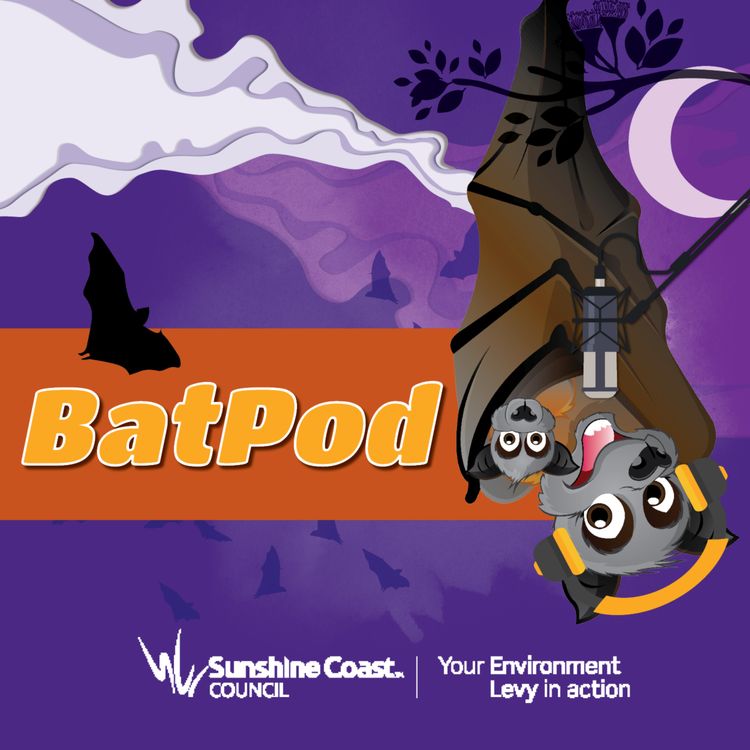Share

BatPod
Episode 4
Sunshine Coast Council have given us 100 Batty Bucks for situations just like this one. First up we need to improve the situation for Sam and the other residents as soon as possible. But we also need to consider the well-being of the flying-foxes.
We need to find an answer that is sustainable and works – for both humans and flying-foxes.
You have four options. Once you’ve made your decision go to the numbered episode which corresponds with your choice.
Option one – dispersal (Episode 5)
Flying-foxes come home really early in the morning. If we use things like smoke, loud noises, lights at sunrise, we can scare them away.
However there is a catch. There’s no guarantee the flying-foxes will leave forever, they could come back a few weeks later, so we have to keep doing it for a really long time – which is also pretty disruptive to neighbours. Now if the flying-foxes do leave this area, they might just go somewhere nearby. Something else to consider is, that this method is actually quite harmful for the flying-foxes – imagine getting scared every night when you try to go to bed and having to run to another room.
Lastly you need to think about the price, it’s expensive. It’s 90 Batty Bucks, so you’d be using nearly your whole budget. But I guess there is a chance they will leave this area.
Option two – make a buffer (Episode 6)
By removing some of the trees or using sprinklers we’re able to push the flying-foxes back a little from the houses. So they’re further away, which makes them a little less noisy and smelly. By using this method we haven’t bothered the flying foxes too much and there’s little impact on the environment. But they will still be there and some people may still be affected.
Creating a buffer costs 30 Batty Bucks so it’s a start – and you won’t break the bank. But you haven’t really solved the problem because the flying-foxes will still be there.
Option three – create a flying-fox habitat in a different location (Episode 7)
By planting trees and building creeks away from houses, it gives flying-foxes food and habitat away from people. This means less impact on humans like Sam, and the flying-foxes are happy too. Problem solved! Not quite.
It can take up to 20 YEARS for the new habitat to be ready, so it does not get rid of the problem now. But on the plus side it only costs 20 Batty Bucks.
Option four – education (Episode 8)
Things like school talks, TV shows, books and videos, maybe even a PODCAST! – anything to teach people how important flying-foxes are to the environment. This means more people understand how important they are in keeping our forests healthy and they may not be as angry towards them.
This option doesn’t damage the environment and it only costs 15 Batty Bucks.
More episodes
View all episodes

BatPod trailer
01:26|We are excited to share our new podcast – BATPOD – a choose your own adventure series for ages 10–15! We live in one of the most beautiful parts of the planet and we get to share it with some amazing creatures. Sometimes it can be hard living near them – take flying-foxes for example. These animals are vital to our environment but they can be noisy, smelly and messy neighbours. Your invited to join Tyron, and our team at Sunshine Coast Council, to try and problem solve ways to live alongside these animals peacefully.1. Start here
12:20||Season 1, Ep. 1Sunshine Coast Council acknowledges the Sunshine Coast Country where this podcast was recorded, home of the Kabi Kabi Peoples and Jinibara Peoples, the Traditional Custodians, whose lands and waters we all now share. We wish to pay respect to their Elders – past, present and emerging – and acknowledge the important role First Nations People continue to play within the Sunshine Coast community.Welcome to Bat Pod! Sunshine Coast Council’s choose your own adventure podcast about flying-foxes. If you are aged 10 to 15 then this is the RIGHT mission for you! We live in one of the most beautiful parts of the planet – we’ve got the stunning coastline and breathtaking hinterlands – the Sunshine Coast really is paradise… So it’s not surprising other creatures want to live here too – but sometimes, they actually have no choice. Like for flying-foxes – they’re living closer to humans because of habitat loss across Australia. These animals are vital to our environment – however, they can be noisy, smelly and messy neighbours.So join me, Tyron, and the team at Sunshine Coast Council as we try to problem solve ways to live alongside these animals peacefully. Key points from this episode:• Flying-foxes are also known as bats or fruit bats because they eat fruits, nectar and pollen.• They’re mammals, they usually give birth to one live young per year. • They are part of the order Chiroptera, which means they’ve got hand wings – and have five digits.• On the Sunshine Coast we have three main flying-fox species – the little red flying-fox, the black flying-fox and the grey headed flying-fox. • The Sunshine Coast region is made up of land of two First Nations groups – the Kabi Kabi and the Jinibara people. They’ve been here for tens of thousands of years.• Flying-foxes are the main night time pollinators – which means many species of plants rely on them. • Flying-foxes play a vital role in the pollination and seed dispersal of more than 100 plant species . • Without flying-foxes there would be no Koalas.Go to Episode 1.2. Episode 1
06:57||Season 1, Ep. 2In episode 1, we meet Uncle Lyndon Davis and Uncle BJ MurphyKey points from this episode:• Flying-fox in Kabi Kabi language is Garrimundi or Girrimundi • Flying-fox in Jinibara language is Bar BarUncle Lyndon asks what town is named after flying-foxes. Here’s a hint – it sounds similar to a word you learnt in this episode…If you think it’s Kawana, go to the episode titled Kawana.If you feel like the correct answer is Currimundi, go to the episode called Currimundi.3. Kawana
00:51||Season 1, Ep. 3You’ve chosen Kawana – listen in to see if it’s the correct answer..........................................................................................Kawana is the incorrect answer. Kawana is actually derived from the Kabi Kabi word for wild flower - guana. So Kawana actually means Place of the Wild Flower. In Kabi Kabi culture this region is women’s country. Go to the episode titled Currimundi.4. Currimundi
02:25||Season 1, Ep. 4You’ve chosen Currimundi – listen in to hear if it’s the correct answer............................................................................Currimundi is the correct answer. It translates into Place of the Flying-fox and is derived from the Kabi Kabi words Garrimundi or Girrimundi.To learn more about Jinibara and Kabi Kabi culture, you can contact:Uncle BJ Murphy at https://www.munnimbahdja.comUncle Lyndon Davis https://www.facebook.com/gubbigubbidanceAt the end of this episode you are faced with a challenge. You find a flying-fox lying on the ground but you’re not sure if it’s sick or injured. What do you do? Pick up the flying-fox to get a closer look to see if it has an injury or illness? Go to episode 2.Or, tell the nearest adult and call the RSPCA on 1300 ANIMAL? Go to episode 3.5. Episode 2
01:41||Season 1, Ep. 5You decide to pick up the flying fox to see if it’s sick or injured. This is the incorrect answer as flying-foxes are wild animals and can carry diseases. To find out the correct answer go to episode 3.6. Episode 3
02:23||Season 1, Ep. 6You are correct! You should never pick up or touch a flying-fox as they might carry diseases. If you find an injured or sick animal, tell an adult, and call the RSPCA on 1300 ANIMAL.8. Episode 5 – dispersal
05:02||Season 1, Ep. 8By using the dispersal method not only did we use most of the budget, we just moved the flying-foxes to a nearby location, not solving the problem at all - in fact we potentially made it worse. Local residents have lost sleep from the morning noise, damaged property from the smoke and their pets have been affected. And to top it all off the native wildlife has also been scared away. Using the dispersal method is not an ideal option, at least to start with. So let’s try again. If you want to try the buffer method, go to episode 6. If you’d like to create a new habitat for the flying-foxes, head to episode 7. And if you want to use education as your first port of call, go to episode 8.